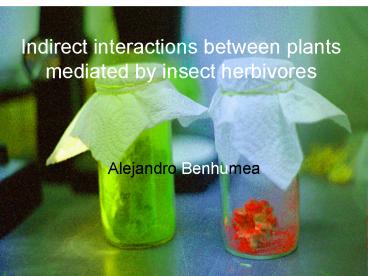Indirect interactions between plants mediated by insect herbivores - PowerPoint PPT Presentation
1 / 25
Title:
Indirect interactions between plants mediated by insect herbivores
Description:
Cholla Cacti. Grows in cylindrical segments. Main plant density occurs at the base of los pinos. ... 'Bug abundance on cholla cacti is greater on plants closer ... – PowerPoint PPT presentation
Number of Views:169
Avg rating:3.0/5.0
Title: Indirect interactions between plants mediated by insect herbivores
1
Indirect interactions between plants mediated by
insect herbivores
- Alejandro Benhumea
2
Direct Interactions
Water
Associational Susceptibility
-
-
Indirect Interactions
Water
3
Overview
- Plants
- Bugs
- Hypothesis
- Methods
- Data
- conclusion
- QA
4
Opuntia imbricata (cholla) Opuntia phaeacantha
(Prickly Pear)
5
Cholla Cacti
- Grows in cylindrical segments.
- Main plant density occurs at the base of los
pinos. - Structure prevents plant from being eaten by
larger mammals - Cholla are much more abundant than the prickly
pear
6
Prickly Pear Cacti
Cladodes
Fruits
7
Narnia pallidicornis
- Juveniles/Adults
- Reproduction
- Predators
- Insect abundance
8
Adult
Proboscis
Old Fruit
Juvenile
9
Reproduction
Eggs
- Juveniles will depend on their host plant until
they are adults.
- Juveniles that have hatched
10
Hypothesis 1
Bug abundance on cholla cacti is greater on
plants closer to the prickly pear cacti.
11
Method
- Chose random Prickly pear and surveyed the
surrounding cholla within a 15 m Radius. - Surveyed 108 Cholla plants
- Took GPS coordinates for each plant with an
accuracy of .5-1 meter to be able to measure
plant distances.
12
(No Transcript)
13
Data
2006 Observational Data
5-10
10-15
0-5 m
0
Distance from prickly pear
14
2004 Observational Data.
10
significant effect of distance,
P
0.015
A
9
8
7
6
B
5
bugs per plant
B
4
3
2
1
0
0-5 m
5-10 m
10-15 m
Distance from prickly pear
15
04-06 comparison of prickly pear Fruit Production
80
70
60
50
2006 fruits
of fruits Per Plant
40
2004 fruits
30
20
10
0
16
Hypothesis 2
- insects released on high quality plants will
stay closer than insects released on low quality
plants.
H
17
Methods
Bug capture, marking and releasing. With a 24 hr
wait time.
24 hr.
I will be marking and releasing 30 insects per
plant.
18
(No Transcript)
19
Fruits
Fruits were taken from nearby prickly pear and
placed on the plant that would be in the
experiment.
15 Or 5
Prickly pear inside the experiment
Prickly pear outside of experiment
20
Predictions
- By simulating Over Population, the bugs will move
out with proportion to the available food source. - Bugs will feed on fruit even though it had been
cut off from the plant. - I am expecting the dispersal to be gradual over 2
or 3 days. Changed it to 24 hours - I am also expecting this experiment to follow
closely with - My first hypothesis.
21
Results of experimental release
0.12
no significant effects of treatment or distance
0.1
0.08
proportion recovered per plant
low quality
0.06
high quality
0.04
0.02
0
0-5
5-10
10-15
Distance from prickly pear
22
Predators
Jumping Spider
Praying Mantis
Northern Mockingbird
23
Conclusion.
- The associational interaction from insects varies
from one time frame to another - In a Arid ecosystem climate changes over the
years influence fruit abundance and the indirect
interaction of plants through a mediated insect
herbivore.
24
Questions
?
?
- ?
?
?
?
?
?
?
?
?
?
?
?
?
25
A Big Thanks to
- Sevilleta LTER
- Fish and Wildlife
- Jennifer Johnson
- Brenda Nieto
- Andrew Romenger
- Ashwana Fricker
- Tom Miller































